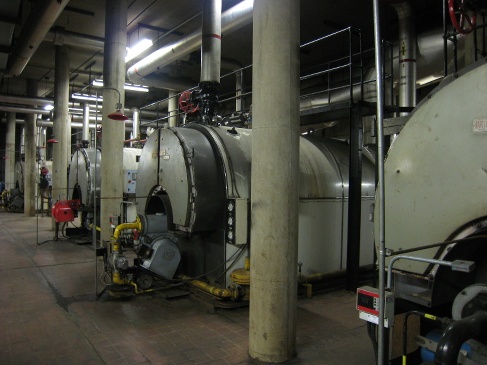You are viewing 1 of your 1 free articles
The story of the Camberwell Submarine
A private finance initiative deal in south London was meant to retrofit an ageing communal heating system and save tenents money. Keith Cooper investigates what happened next
Video:
features code

The Camberwell Submarine, the concrete chimney of an underground energy centre on a Lambeth housing estate, is aptly nicknamed.
The periscope-like vent is at the centre of a serious skirmish between the south London local authority and many of its residents.
The battle is about a most basic resource - heating and hot water - and how it’s supplied to two adjoining estates: Myatts Field South (MFS) and Myatts Field North (MFN), where the submarine sits. The issues arose following a regeneration scheme that has changed the face of the estate. Given that the government is pushing for the large-scale regeneration of the UK’s housing estates, the lessons from Myatts Field will be of relevance to scores more schemes in the coming years. It acts as a clear reminder to landlords that not only do they have to think about tenure and the physical environment, but also how services are procured and provided if they don’t want to end up in hostile dialogue with residents.
Video:
Ad slot
Fuel poverty
In the case of Myatts Field, Lambeth Council has ended up in a protracted battle with residents, who have criticised its management of the regeneration and say their bills have increased as a result.
“These properties are not designed for single boilers.”
Lucy Williams, chair, Myatts Field South TRA
The south-siders accuse Lambeth of pushing tenants on low and unstable incomes into fuel poverty. Around a third of the 393 households on MFS are resisting having individual boilers installed, after they were disconnected from the energy centre and denied access to the refitted submarine. They are campaigning for their own communal heater but are living on borrowed time. Lambeth plans to switch off their temporary communal supply this summer and is threatening the 119 or so refuseniks with legal action.
Source: Mike Urban/Brixtonbuzz.com
The district heating system boiler at Myatts Field looks like a submarine
But the council is facing a war on two fronts with tenants on the 477-home MFN and the new ‘Oval Quarter’, a development of 503 private homes being built around MFN. They are all hooked up to the refitted submarine but complain Lambeth has tied them to an onerous deal with energy giant E.ON from which they cannot escape for decades.
Trouble in the south
So how did these battles reach boiling point? And what are the lessons for other landlords?
The trouble on the south is traceable to 2010 and a private finance initiative (PFI) project to regenerate MFN.
Under the PFI, a consortium called Regenter would replace 305 rundown council and leaseholder homes, do up 172 others and build 187 new ones for sale. It would refit the submarine with a combined heat and power (CHP) plant to supply both estates, say council papers approving the plan in March 2010.
The refit appeared a welcome benefit of the PFI, as the submarine’s ageing KC1 heater neared the end of its life. While then supplying the south estate, homes on the north had been disconnected and switched to
individual boilers in the 1990s.
Lambeth and Regenter duly negotiated with the MFS tenants’ and residents’ association (TRA) to connect the estate to the submarine. A budget of £4.5m was agreed to lay the pipework and replace radiators, according to the TRA’s then chair, Lou Weston. Lambeth and Regenter confirm discussions took place.
But within months of approving the 2010 plan, Lambeth appeared to rethink its intention to connect MFS to the refitted submarine. Sometime between April and November, the authority asked consultancy, the Brinson Staniland Partnership (BSP), to explore alternatives for MFS.
The resulting report examined three choices: a dedicated communal heater; individual boilers or a mixture of both. Connection to the submarine was not an option.
BSP’s conclusion that December infuriated residents. It recommended the option of individual boilers for its “lowest capital cost”, despite describing a dedicated CHP plant as the “most efficient option”.
In 2011, the final business case (FBC) for the PFI, obtained under the Freedom of Information Act, indicates why Lambeth pursued these alternative options at that time. While the original rebuild and refurbishment programme was unchanged, the number of private homes in the PFI was almost trebled from 187 to 503. This left the energy centre without capacity, the FBC says.
The next year, the south-siders were connected to a temporary heater and disconnected from the submarine, which was handed to Regenter for the refit.
By this time, E.ON had been awarded an exclusive contract to refit the submarine and use it to supply gas heating and hot water to MFN for 40 years. This arrangement promisingly pledged “substantial reductions in energy costs”, so says the PFI’s final business case in 2011.
In 2013, a separate report about MFS heating options, by Astec Consultant Services, also recommended individual boilers, claiming it was “more than likely that most residents will be financially better off” with them.
Contesting claims
This claim is strongly contested by the Myatts Field South TRA. Its chair, Lucy Williams, claims correctly that the consultants’ cost calculations do not account for the estate’s draughty physical structure or the considerable heating effect of the communal system pipework.
“These properties are not designed for single boilers,” Ms Williams says. “When the communal heating is switched off, the whole estate will become like a graveyard. Heating costs are going to escalate.” Lambeth confirms the estate structure and the heating effect of communal pipes are not factored into consultants’ calculations.
The TRA says tenants will struggle with individual boilers and higher bills after so long on a fixed-rate communal supply. Its concerns are confirmed by several residents.
Karker Sdqi, a 24-year-old Kurdish refugee from the war-torn Iraqi city of Mosul, who agreed to an individual boiler soon after he moved in, says he never switches the heating on. His monthly bill of around £50 is less than the £56 fixed fee he paid on the communal. But as a chef, picking up ad hoc agency work, he worries about covering increases. “I wear a lot of clothes and use an electric fan. I always worry about how much I am spending. Before, I wasn’t.”
Sylvia Fulwood, a 91-year-old resident who has lived on the estate since 1981 and whose home is on the communal heater, is worried about switching. She says she “would use all my pension to pay for the heating” if forced to switch to an individual boiler.
Concerns about fuel poverty are recognised by Lambeth, which is encouraging struggling tenants to seek help. It aims to secure cheaper energy deals for tenants with utility companies. “Court action has been taken as a last resort to enable us to complete the works before the old communal system fails catastrophically,” the spokesperson adds. “Decaying pipework is leaking thousands of litres of water weekly.”
Lambeth told Inside Housing that in 2014, E.ON “confirmed” its energy centre had the capacity to supply MFS but that this would require “major alterations” and a road closure to lay a new mains. “The benefits would be far outweighed by the substantial costs involved,” he adds. E.ON says it would be “happy to explore” extending the energy centre to MFS.
The TRA’s Ms Williams says it had not been informed about the possibility of connecting MFS to the submarine in 2014. It has been campaigning for Lambeth to use the £4.5m funding, it says was agreed, to pay for a new permanent communal heater on the MFS estate. Lambeth says there is no “committed resource” agreed under the PFI deal for this purpose.
High bills
Meanwhile, on the other side of the estate, a number of tenants on MFN and the Oval Quarter are not happy either after being hooked up to the retrofitted submarine.
The fact that residents on both the north and south sides are unhappy despite the major work carried out, shows how important effective consultation is to the ultimate success of a scheme.
Papers seen by Inside Housing reveal the energy plant installed by E.ON has been beset by problems of poor performance and complaints about high and unpredictable bills.
A 2015 report for the MFN project liaison group, established to keep tabs on the PFI, lists a range of problems from the preceding three months, resulting in a “poor level of service”.
Many residents received inaccurately inflated estimated bills because of problems with “automatic meters”, which were meant to beam readings directly to E.ON. Four in 10 were delivering erroneous figures, the report says.
The problems with automatic meters continued to at least last December, according to a letter by E.ON’s head of community energy, Jeremy Bungey. “We are… unable to guarantee one accurate bill a month,” it states.
MFN leaseholders and private residents on the Oval Quarter development are also upset about their monthly standing bill of £33 to cover boiler repairs and replacement costs.
Tenants concerned
Uzoamaka Okafor, chair of the MFN Residents’ Association and PFI Monitoring Board, told Inside Housing tenants remain fed up with the service: “People are concerned about bills, they are so high and unpredictable. It is supposed to be sustainable energy, it is supposed to be cheaper, but I can’t see it.”
One tenant, Maria Cifuentes, says she no longer used the E.ON supply for heating, after receiving several monthly estimates in excess of £120. While these were reduced on appeal, she feels more in control of costs by using electric heaters.
“Many residents have been turning off their heating because they can’t afford the bill.”
Stuart Hodkinson, lecturer, University of Leeds
Lambeth responded to the TRA’s petition in February 2015, admitting there was “no opt out” for tenants in the 40-year contract.
In May, a fact sheet by Regenter suggested why tenants’ bills may appear high. E.ON’s gas tariff is “derived from the average gas tariffs of the big six suppliers”, it states. This average is then “multiplied by 1.25 to account for the efficiency difference” between its CHP and “traditional gas boilers”.
E.ON told Inside Housing the multiplier was used as an “academic exercise” to compare its prices to the market, not to set them. The average bill across the estate was £580 a year, “compared favourably with the UK average” and was “considerably less” for social tenants as the council contributes towards their charges, a spokesperson added.
Stuart Hodkinson, a lecturer at the University of Leeds who was funded by the Economic and Social Research Council to investigate the PFI project, says he is sceptical about E.ON’s average bills figure.
“Many residents have been turning off their heating because they can’t afford the bill,” he adds. “They are being dispossessed of their consumer rights - forced to pay for a system that doesn’t work for them, has been unreliable and from which they cannot escape.”
An E.ON spokesperson admits to “initial problems” on the estate with billing accuracy. It had apologised to customers and “worked hard to rectify” issues. “We are seeing improvements in service levels,” he adds.
As the battles on MFN and MFS show, keeping residents warm when they are on low incomes is a serious consideration for social landlords pursuing regeneration plans. How they meet that challenge will be a key test of their commitment to tenants’ well-being.
Hot under the collar: the troubles with district heating systems
Ministers’ drive to rebuild scores of ‘sink estates’ runs alongside another to hook eight million homes up to district heating by 2050.
This big push for district heating systems is not without controversy, however.
A study of 59 systems by consumer champion Which? last year uncovered “significant dissatisfaction” among consumers. High prices were a widely held concern, the report, Turning up the Heat, found.
Lack of regulation of heat networks and being unable to switch supplier were cited as major issues.












